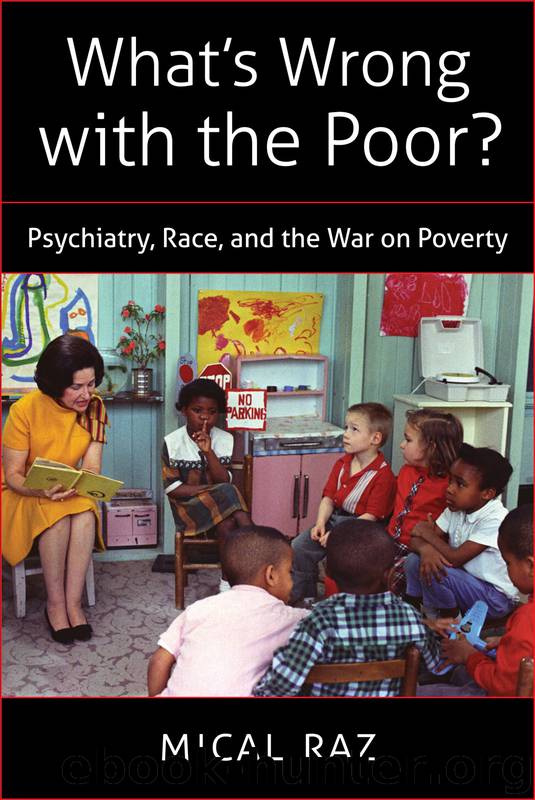What's Wrong with the Poor? by Raz Mical

Author:Raz, Mical
Language: eng
Format: epub
Publisher: The University of North Carolina Press
Published: 2013-03-14T16:00:00+00:00
Intervention or Resegregation?
By the late 1960s, however, race could no longer be ignored. In 1967, Julius Hobson, an African American civil rights activist, filed a lawsuit against Carl Hansen, superintendent of the Washington, D.C., public school system.93 Prompted by scholastic testing that led to the exclusion of his ten-year-old daughter from the college preparatory track at her school, Hobson sought to end to what he viewed as the systematic denial of educational opportunities to African American children by means of ability grouping and tracking along with blatant inequalities in the allocation of resources.
Tracking had been in place in the Washington, D.C., schools since 1956, when Hansen, the system’s associate superintendent at the time, instituted an extensive reform of high school education designed to reduce academic heterogeneity within each classroom. This system was set in place soon after the District of Columbia schools were desegregated. The 1954 Brown v. Board of Education decision was rapidly implemented in the District, bringing children from different racial, economic, and scholastic backgrounds into the same classrooms. The tracking system Hansen devised necessitated that each high school student be placed on one of four tracks: basic, general, college preparatory, and honors. The basic track was targeted at children who scored less than seventy-five on IQ tests—the contemporary definition of “mentally retarded.” Hansen was a staunch supporter of desegregation, traveling across the country to lecture on the city’s perceived successful desegregation of its schools, and he insisted that the tracking system was about ability rather than race.94 At a time when inner-city school districts faced the challenges not only of desegregation but also of a steady of influx of poor African American families from the rural South, Washington’s high school students improved their scores on standardized tests, sending a higher proportion of black students to colleges than any of the nation’s other urban school systems.95 Thus, while some critics had questioned the tracking system in the late 1950s, Hansen’s approach was widely supported until the middle of the following decade. In fact, when Hobson attempted to organize a school boycott in 1967 to protest the tracking system, he received little support from the black community; many parents were pleased with Hansen, his methods, and perhaps most significantly, his results.
Hobson v. Hansen was groundbreaking in that it called attention to the racial implications of the tracking system. Hobson argued that the intelligence tests that served as the basis for grouping had been standardized according to results from Euro-American children and thus were culturally biased. Furthermore, he argued, they inaccurately predicted academic success for children from low-income or African American homes. Judge J. Skelly Wright of the Washington, D.C., Court of Appeals excoriated the city’s tracking system.96 The tracking closely corresponded with race, creating de facto segregated classes in desegregated schools and was therefore found to be discriminatory and unconstitutional. Wright’s verdict was the first of many that addressed the question of scholastic tracking and its correspondence with race, ethnicity, and economic status and called public and professional attention to the overdiagnosis of African American children as “mentally retarded.
Download
This site does not store any files on its server. We only index and link to content provided by other sites. Please contact the content providers to delete copyright contents if any and email us, we'll remove relevant links or contents immediately.
| General | Discrimination & Racism |
Nudge - Improving Decisions about Health, Wealth, and Happiness by Thaler Sunstein(7191)
iGen by Jean M. Twenge(5125)
The Fire Next Time by James Baldwin(4986)
Adulting by Kelly Williams Brown(4197)
The Hacking of the American Mind by Robert H. Lustig(4051)
The Sports Rules Book by Human Kinetics(4045)
The Ethical Slut by Janet W. Hardy(4008)
Captivate by Vanessa Van Edwards(3698)
Mummy Knew by Lisa James(3495)
In a Sunburned Country by Bill Bryson(3331)
The Worm at the Core by Sheldon Solomon(3293)
Ants Among Elephants by Sujatha Gidla(3260)
Suicide: A Study in Sociology by Emile Durkheim(2885)
The Slow Fix: Solve Problems, Work Smarter, and Live Better In a World Addicted to Speed by Carl Honore(2818)
The 48 laws of power by Robert Greene & Joost Elffers(2739)
Humans of New York by Brandon Stanton(2661)
Handbook of Forensic Sociology and Psychology by Stephen J. Morewitz & Mark L. Goldstein(2588)
The Happy Hooker by Xaviera Hollander(2561)
The Tipping Point by Malcolm Gladwell(2528)
